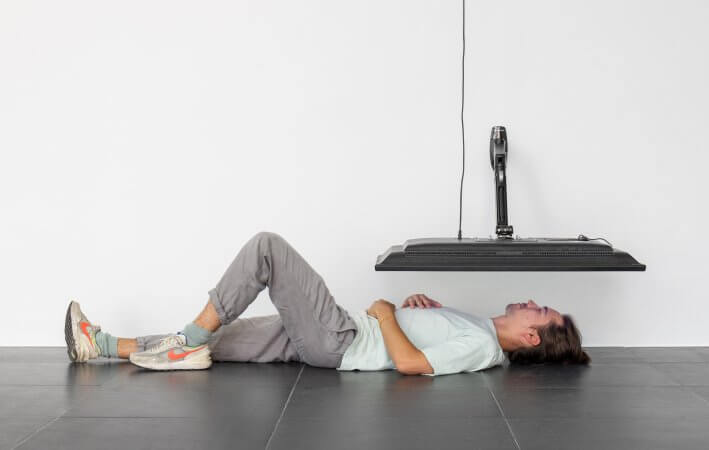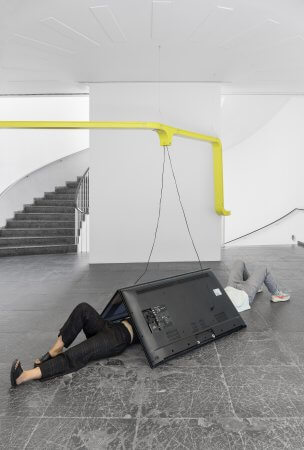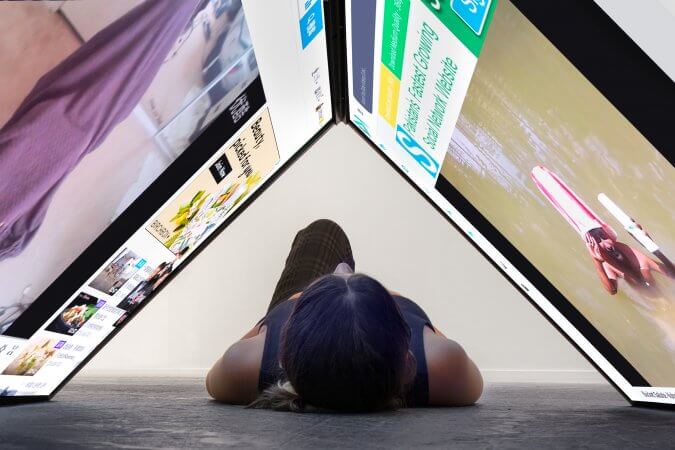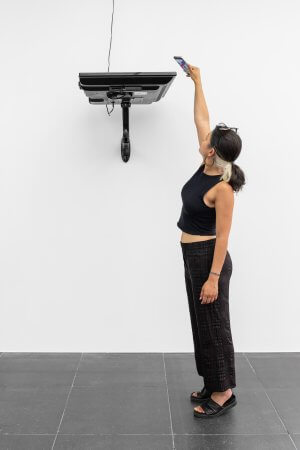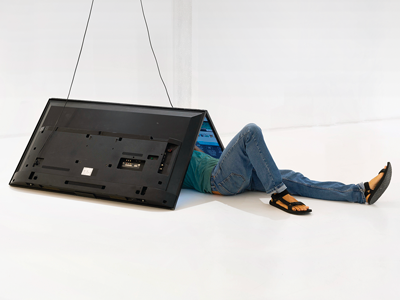BEFNOED, 2013 (ongoing)
Video installation
Five videos, monitors, customized wall brackets, cables
Dimensions and duration variable
Courtesy the artists and Apalazzo Gallery
BEFNOED is the title of an ongoing series of videos that Eva & Franco Mattes have been producing since 2013. These short films are published online, on obscure, peripheral or forgotten social networks around the world, in Cambodia, Russia, China or Pakistan, without comment and without reference to any art project: places where the works are meant to be found almost by chance.
The videos show people carrying out seemingly meaningless actions that they have received as instructions from the artistic duo. Eva & Franco Mattes have hired these performers anonymously via online marketplaces for digital services, so-called crowdsourcing platforms. The people film themselves without knowing who the instructions come from, which audience the films are intended for or what goals are to be pursued with them. Different workers interpret the same performance with slight variations: a military salute with a bucket on one’s head, standing on a ladder, licking a car rim, two people connecting their heads through a tube.
For the exhibition, these films are spatially staged in such a way that the viewers, if they want to see the works, also have to perform a physical act that contradicts behaviour normally found in museum spaces.
The visitors have to lie on the floor under a monitor tent or lift each other up in order to look at one of the monitors that points to the ceiling above their heads. If they wish to see the images, they are obliged to squeeze between the monitor and the wall. This creates a physical interaction with the artwork that reveals a correlation between the unaware performers on the net and the unaware performers in the room. In the same way that the digitally recruited workers bow to a request from the artists, so too the visitors must adapt their behaviour to the artwork. Both actions, the digital and the analogue, celebrate absurdity, which at some points can bring to mind Erwin Wurm’s Living Sculptures. ‘We become what we behold. We shape our tools and then our tools shape us’ (Marshall McLuhan). The repetition of externally determined actions online is a highly common and successful practice, upon which the platform TikTok, for example, has built an entire business model.
As with numerous other works by the artistic duo, BEFNOED also works with irony, whereby the user’s behaviour in front of and behind the screen is humorously caricatured.
Eva & Franco Mattes address the mechanisms of labour in the digital world, which trade workforce as a commodity on an internationally digital labour market. The title BEFNOED is an acronym for ‘By everyone, for no one, every day’. Thus, the central question in this video series concerns gig workers, the people in the crowdsourcing economy, their work, authorship and individuality. Someone on the other side of the screen is fulfilling our requests, whether they be clicks, likes, online shopping. An action that seems immaterial to us has a direct impact on someone’s work on the other side of the world.
Crowdsourcing platforms function as anonymous marketplaces for employees and employers looking for short-term jobs for HITs (Human Intelligence Tasks). This concerns all services that can be outsourced online and are summarised by the term ‘human as a service’.
So-called contractors are often interposed between the employee and the employer for the purpose of ensuring the latter anonymity. The advantage of this work model is that it represents a quick and easy way to earn money flexibly. The disadvantage is the risk that workers’ rights and non-wage labour costs are circumvented. As a Facebook content moderator aptly describes in Eva & Franco Mattes’ work The Bots, it creates ‘a digital proletariat and a digital factory that produces no concrete products and is driven by profit alone’.
The first crowdsourcing platform for micro-labour (gigs), Mechanical Turk, was set up by Amazon in 2005. This marked the beginning of an increasingly deregulated labour market or labour pool. Mechanical Turk is the best-known and largest example of a platform where micro-tasks that cannot (yet) be performed using computing power are commissioned at low cost. There is a sense that this is a transitional period in which humans are still doing these kinds of jobs until they are taken over by algorithms. An important point is that it is still much more profitable to exploit low-paid human labour than to pay engineers to develop software. According to estimates, the turks’ average wage is around 2 dollars per hour. The micro work offered is often remunerated with credits on Amazon accounts – thus representing a double profit for the platform. Mechanical Turk was followed by numerous other crowdsourcing platforms such as Clickworker or Appjobber.
The original Mechanical Turk (1770) was a seemingly ground-breaking invention: a chess playing machine commissioned by Empress Maria Theresa of Austria in the early days of the Industrial Revolution. Externally, it resembled the other automata of the time. The machine could imitate the movements of a human playing chess, but a person was hiding inside it. For almost a century, the trick led viewers to believe that a machine could play chess. So the name of the Mechanical Turk platform is intended to suggest something that feels like a machine but has humans behind it. Humans work to fill the gaps of algorithms while training the latter to do a better job in future. For this reason, their work serving algorithms is less and less considered actual work and takes place invisibly in the background. The work BEFNOED provides visibility to these otherwise invisible workers, allowing them to engage in creative actions that are sometimes humorous and occasionally even poetic.

